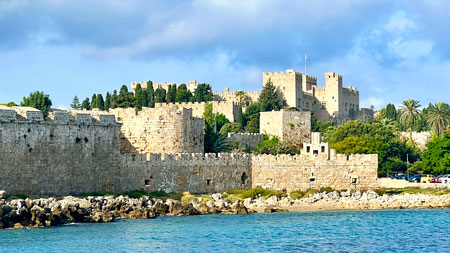
September 28 – October 3, 2022
Rhodes Town
Narrow streets, mosques, fountains, towers, and squares crammed with shops and restaurants, are surrounded by a perfectly preserved moat. This is old town Rhodes, Greece (Rodos to the Greeks).


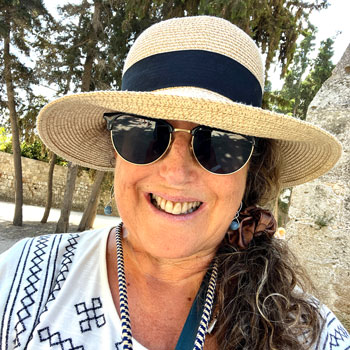










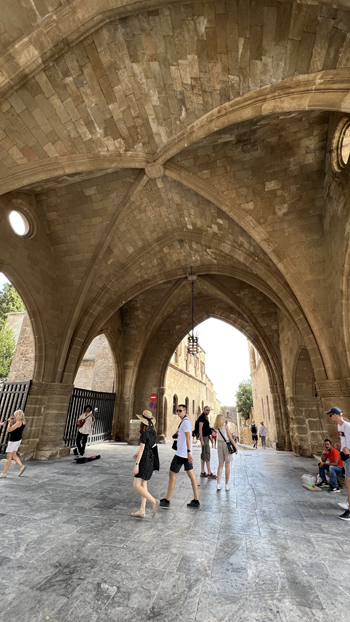




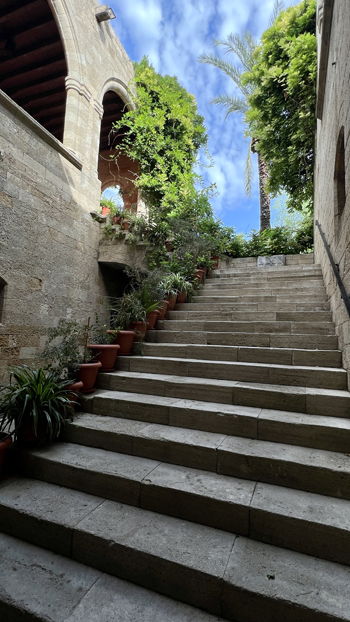
The Myth of Rodos
According to this myth, after Zeus’s victory against the Giants, he decided to divide the earth among the Olympian gods; The only god who received nothing was Helios.

He, according to the myth, was absent and “No one remembered to include him in the draw”! When he came back he demanded his share, but Zeus told him that he was not able to make the cast again because the rest of the gods would not agree. Helios was disappointed but asked Zeus and the other gods to promise that the land that was to rise out of the sea could be his.
As he spoke, a beautiful island slowly emerged from the bottom of the blue sea, Rhodes. Helios bathed Rhodes with his own radiance and made it the most beautiful island in the Aegean Sea.
The Rest of the History



I was going to attempt a condensed version of the history of Rhodes, but found that to be an impossible task. Rhodes has been settled by, conquered by, and been ruled by everyone under the sun (just about).
Early On
First came the Carian tribes in Asia Minor, followed by the Minoans from Crete, the Phoenicians, the Persians, the Athenians and Spartans, the Macedonians, Alexander the Greet, and the Greek Achaeans, and on and on.
The Romans



In the 3rd century B.C. Rome started getting too aggressive in Rhodes’ business, and ultimately forced them to sign an agreement. Same friends, same enemies. That didn’t go well, and Cassius ended up attacking and conquering Rhodes Town in 42 B.C.
St. Paul Visits
Rhodes, strategically positioned near the Holy Land, accepted the new ideas of Christianity with ease. According to tradition, St. Paul himself preached the new religion at Lindos, a major city in Rhodes, in 58 AD and converted many of the inhabitants.
More War



In the first century, Rhodes was often overrun and destroyed by enemies such as the Persians, Saracens and Seljuks.
When the crusaders conquered Constantinople, in 1204, a rich landowner declared himself Despot of Rhodes.
The Byzantine emperors captured their capital back from the Crusaders in 1261, and Rhodes theoretically returned to their control.
The Knights of St. John
In 1306, Rhodes was sold to the Knights of St. John in Jerusalem. For the next two centuries the island of Rhodes was a sovereign state under the rule of the Knights of the Order of St. John.
The Order of St. John was founded during the First Crusade as a monastic order with a medical mission. Its monks ran a hospital for Christian pilgrims in Jerusalem. They were known as the Hospitallers. Under the threat of Muslim invasion, the brotherhood became increasingly militarized and began to provide armed escorts for pilgrims.
Its members swapped their monks’ habits for armor and eventually became a multinational elite fighting force answering only to the pope. When Jerusalem fell to Arabs in 1291, the Hospitallers moved to Cyrpus, then found a new home base on Rhodes.
When the Knights ruled Rhodes, the island became the most powerful in the Eastern Mediterranean. They left imposing evidence of their presence on Rhodes, and gave the city the particular character it retains to this day, with its impregnable walls, gates, churches, hospitals, inns and palaces.
The Knights remained in Rhodes for 213 years until 1522, when, on December 29th, the last of the Grand Masters surrendered the island to Suleiman the Magnificent. The Turkish occupation of Rhodes was the darkest period in its history. Turkish occupation of the Dodecanese lasted until 1912.
And Now the Italians
In that year, the Italians, with the help of the local Greeks, occupied the island. With the rise of Facism, Rhodes began an armed resistance.
Greek Rule
After the defeat of the Axis powers in WWII, Rhodes and the other Dodecanese islands came under British military administration until March 7th 1948, when the Greek flag was finally raised over the Governor’s Palace.
The Gates
In modern Rhodes Town, eight gates, each impressive in its own unique way, lead into the old town, secure within the walls of the ancient medieval city.





We entered the old section of Rhodes Town through the Panayia Gate early one morning, arriving on the ferry from Symi island. It was early enough that only the vendors delivering the ice, fresh seafood caught that day, beer, water, and other wares were out in the streets.
Castles and Knights


If not for those few trucks, we would have thought we had been transported back in time, a time of castles and knights, moats and stone towers. Walking along, dressed in our usual shorts and t-shirts, carrying backpacks, we certainly weren’t dressed for the medieval scene. But no one seemed to notice.
The Hub
Strategically, Rhodes is in an ideal location. For this reason, Rhodes became a hub of sorts for knights from all over Europe. Soon The Street of Knights was born. Seven inns representing the seven countries from which the Knights of the Order of St. John came. They include England, Germany, Italy, France, Aragon, Provence, and Auvergne.
The Street of the Knights





The long, straight, downhill sloping cobblestone street housed the headquarters for each nation’s knights. It runs from the front of the Knights’ Hospital to the Palace of the Grand Master.
It’s one of the best-preserved medieval streets in Europe. We could picture the knights holding business and carousing about, without having to use much imagination.
The Palace of the Grand Master of the Knights of Rhodes

The medieval crowning glory of the island is definitely The Palace of the Grand Master of the Knights of Rhodes.
The Palace, dating back to the seventh century, was awe inspiring. The enormous round towers framing the main entrance made it feel like we were on a movie set.
The grand central square, where we entered the Palace, is flanked on all sides by larger than life statues of important men (and only men) of the time.



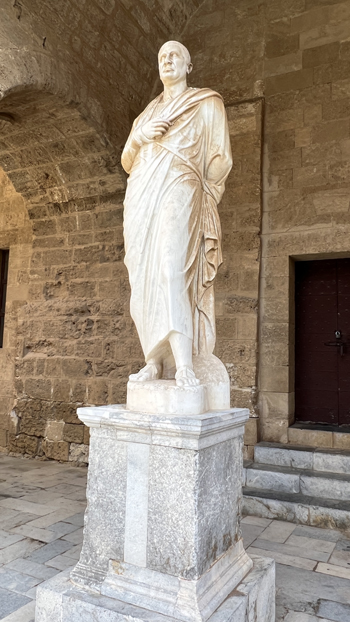
We had paid 8 euros each to enter and arrived right when they opened. It was just us and one other couple. The square is very impressive, but were surprised to find that was it. That was the whole thing. I had expected more from a place with such a long and commanding name.
We decided to milk it for a while. We wandered the square, to get our money’s worth. At some point we noticed the other couple had disappeared into a far corner. Following their lead, we discovered a small, unmarked, and unassuming entrance into the greater castle. Thank goodness there was more. Lots more.





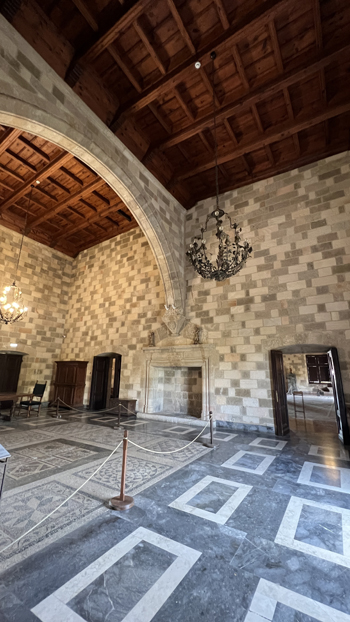
The Dry Moat
We were looking for the Palace entrance, and found ourselves in a huge and never-ending moat. It’s called a dry moat, so its never held any water, but acts as another layer of protection for the palace.




The Archeological Museum of Rhodes

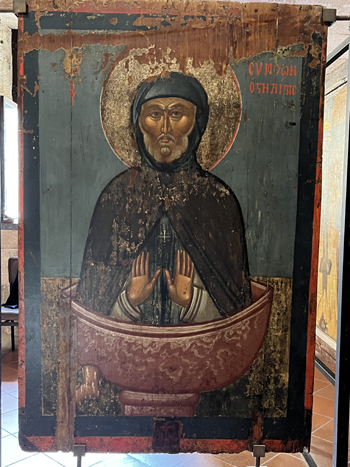

Rhodes Town is home to an amazing Archeological Museum. It’s full of very impressive mosaics dating back to the third century BC.
After a long, but interesting, visit to the museum, we stood just outside the exit to figure out our next move. That’s where we met Sheri from Iowa.









Americans
It really catches your attention when you hear an American here in town. There just aren’t many Americans here, for some reason. We hear lots of Europeans. We hear British accents everywhere. Lots of German speakers, and even an occasional Russian.


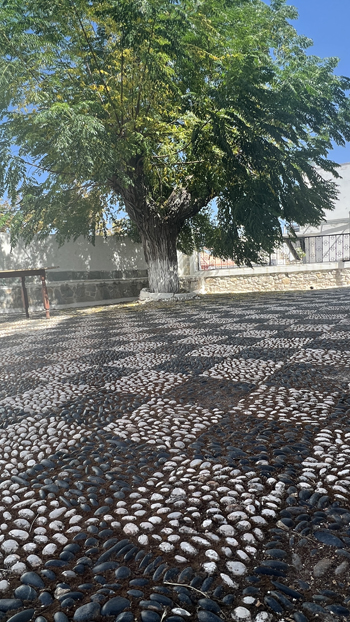
Traganou Beach
We became fast friends with Sheri. It was decided to go on an outing the next day. After some research, we decided to visit a distant beach on the eastern coast of Rhodes, Traganou Beach.






The next morning we met at the Rodos bus station and caught the local bus heading towards Traganou. The bus driver said he’d tell us when to get off. Even so, we followed our progress on our phone app, just in case.
But he remembered. He signaled for us to get off, as he pulled over on the Turkish highway. We were about a half-hour out of Rhodes Town. The three of us hustled down the bus stairs, and as we exited he gave a shout, “Good luck. Be careful”.
What?? Good Luck?? Be careful??
It was a little alarming to get such a warning. We hoped it was just a Greek translation gone-wrong. We were, however, being dropped off in the middle of nowhere, on the side of a busy highway.
It was a bit of a hoof down a country lane in the blazing mid-morning sun. But the beach at the dead-end was beautiful and we had a lovely day.
The West Coast
The next day Sheri had rented a car. She invited us along on an adventure into the mountains and down the west coast of the island.
In most situations, Google maps is your friend, until it turns on you and directs you down an obscure dirt road. A dirt road that winds down a mountainside and is presumably a short-cut. No thank you.
Consequently, after a quick switch to WAZE (another navigation app), we made it to our destination, the town of Kritinia.

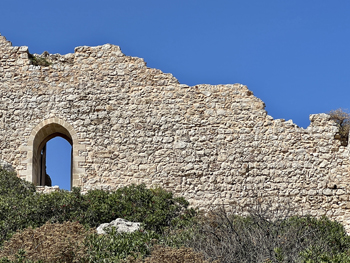
Before reaching Kritinia, we drove high into the mountains covered in pine forests. We had stunning views and happened upon a 15th century small church with amazing, intact frescos (paintings on the walls).



After lunch in the small town of Kritinia, we headed to the Kritinia Castle.
Kritinia Castle

We hiked up, up, up to the castle. There we were rewarded with a spectacular view of the turquoise waters along the coast.

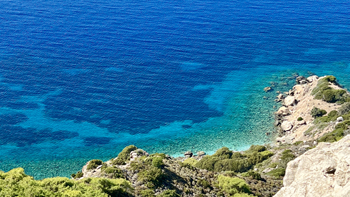
Ancient Kamiros, Rhodes


Lastly we drove to the archeological site of Kamiros. Kamiros was one of three large ancient cities on the island dating back to 1400 B.C. that united in the 5th century B.C.. The union of these cities created one powerful state, Rhodes.
WINS & LOSSES
Dinner Out

Ten minutes after ordering dinner the waiter comes over and stands at the end of our table for a moment. He then asks if we are sure we wouldn’t like an appetizer, because the cook is away. He will be back in about 15 or 20 minutes.
Ok then. We ordered the zucchini fritters, but we were really wondering who was going to make them. Stouffers maybe?
Yiannis Homemade Turkish Food
We had two wonderful meals at Yiannis Restaurant, not far from our hotel. Yiannis, the owner and cook, was quite a character. She had a stern side for sure. She seemed like a force to be reckoned with.
It was a family run place, like many in Greece. The family weren’t shy about having loud disagreements and discussions in and outside the kitchen, well within hearing range of the patrons.

Fish Food Revisited
Just like on Symi Island, a fish decided to give me a taste, right on the thigh this time. And Sheri, our new friend from Iowa who was with me in those dangerous waters, also got nibbled. Not sure why, but no one else seemed to get nibbled but us. Go figure.
Sofia’s Pension

Sofia, of Sofia’s Pension where we stayed, was so lovely. Sofia had lived in New York 30 years ago, and had a soft spot for Americans. Gotta love that.
My laptop completely rejected Sofia’s internet router, so much so that I had no internet for a week.
Like in the dark ages.
Very nice❤️ Looks like an area we would love to visit.
It was lovely, but very very very touristy. It’s considered shoulder season, but there were sooo many people around. I can’t imagine what it would be like in prime season!
Awesome looking castles. Looks like a lovely leg of the trip.